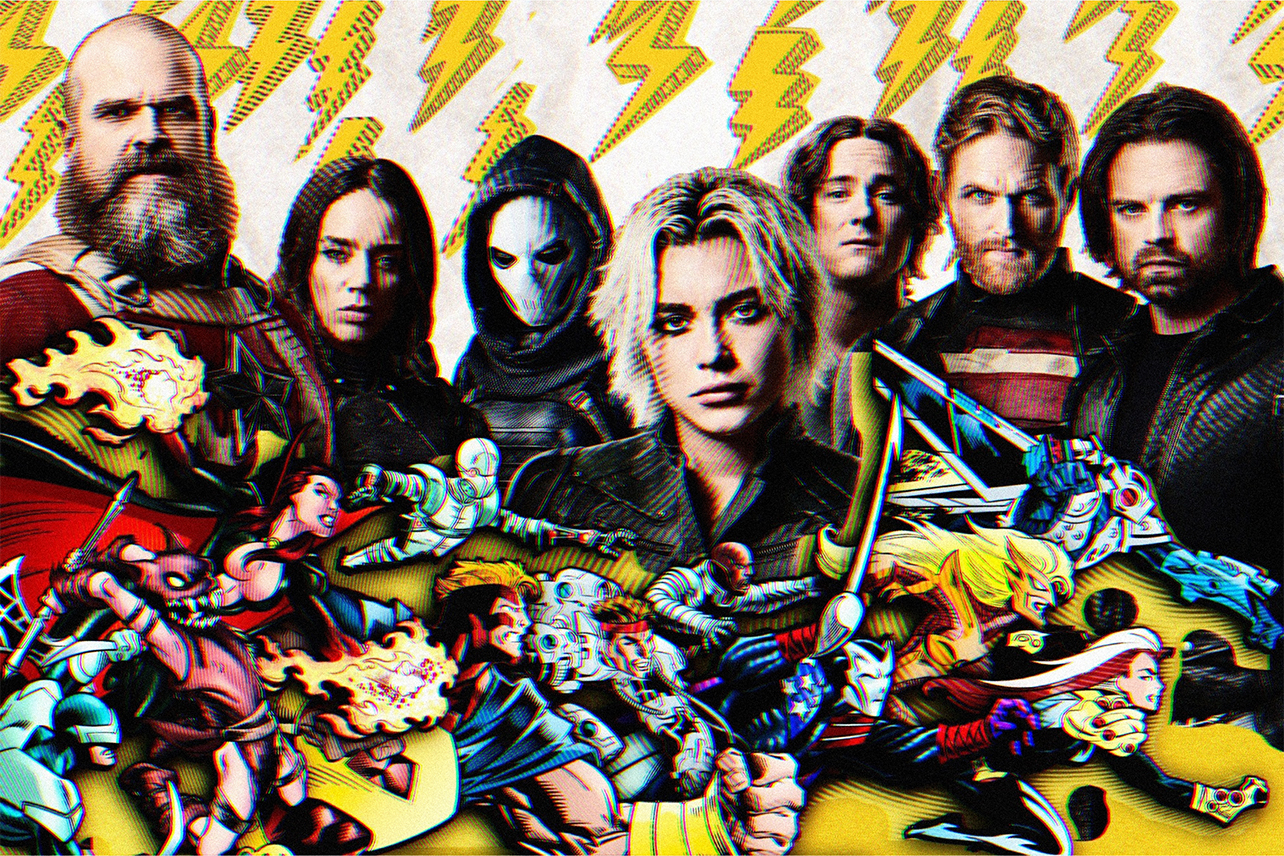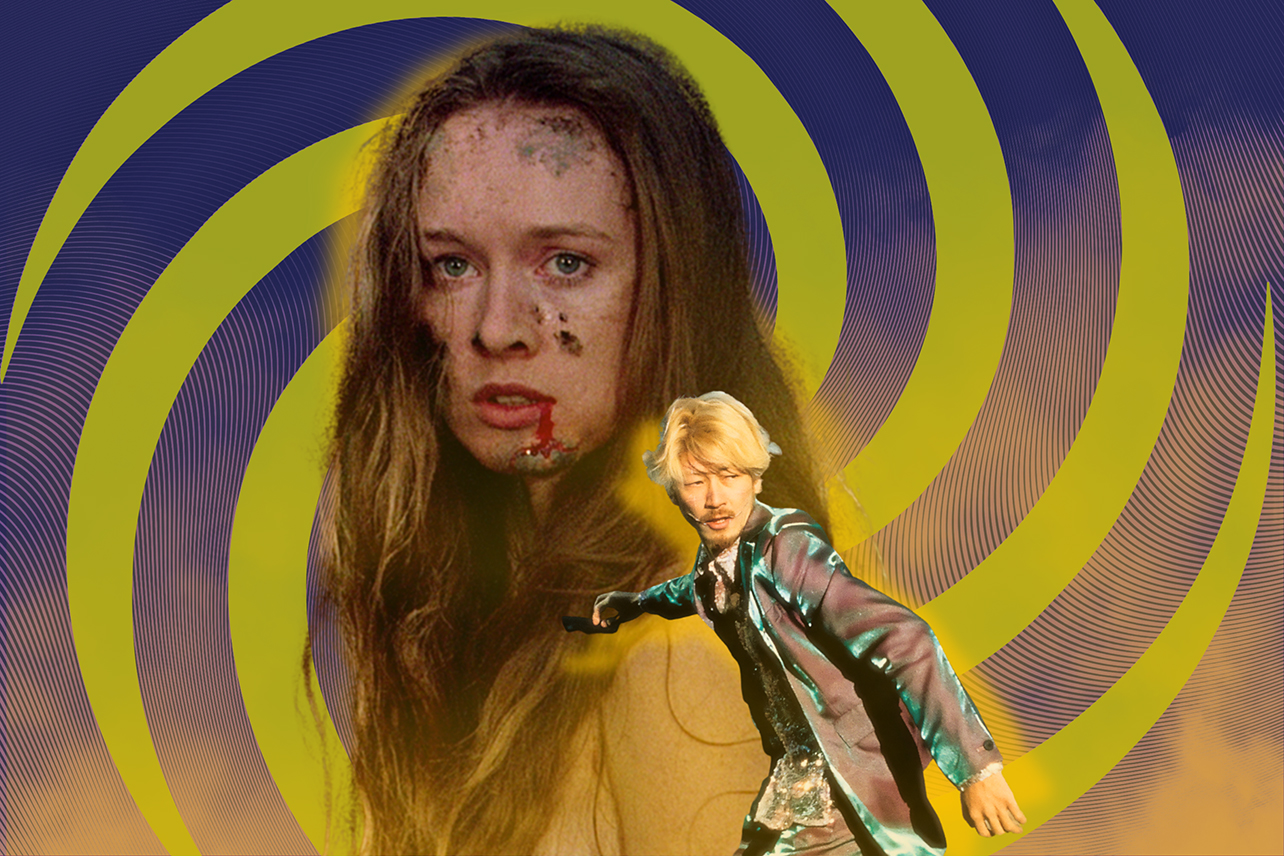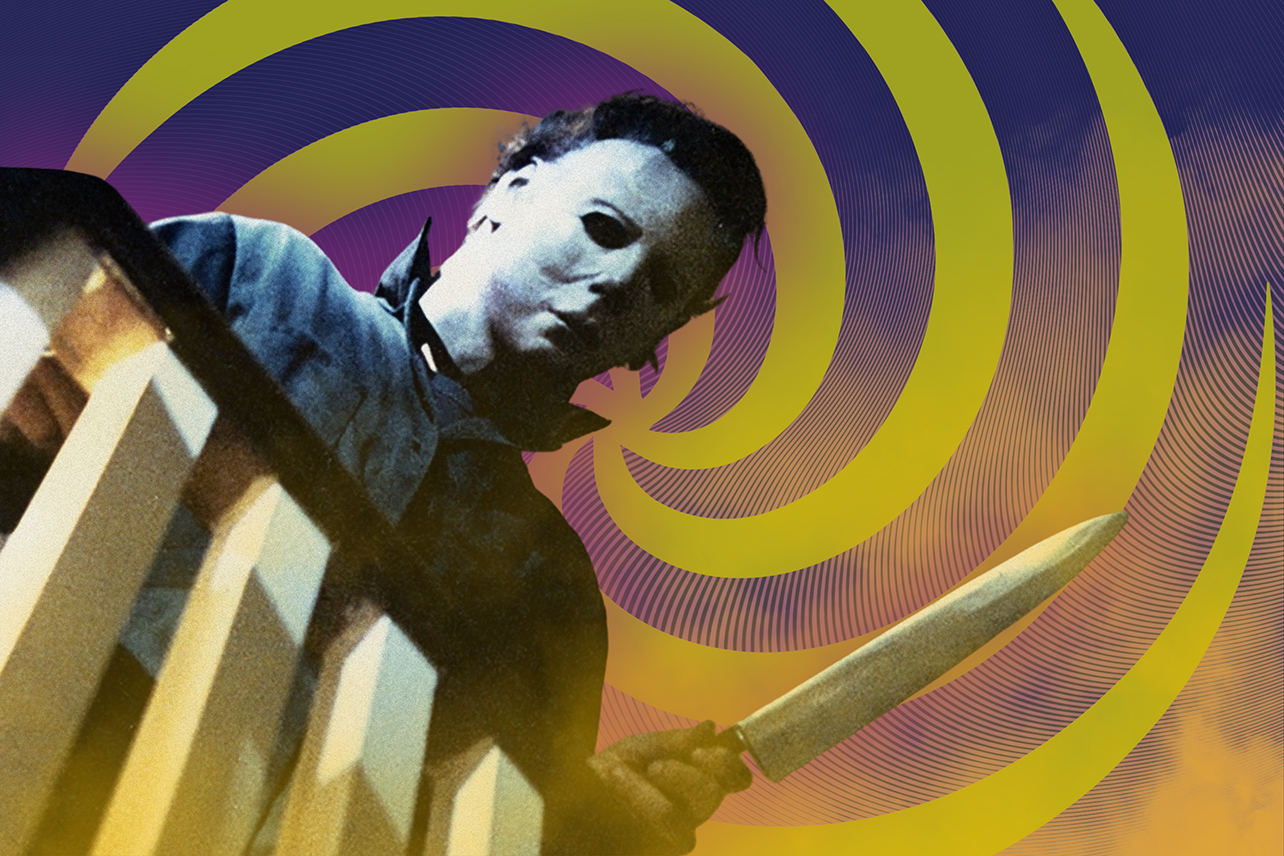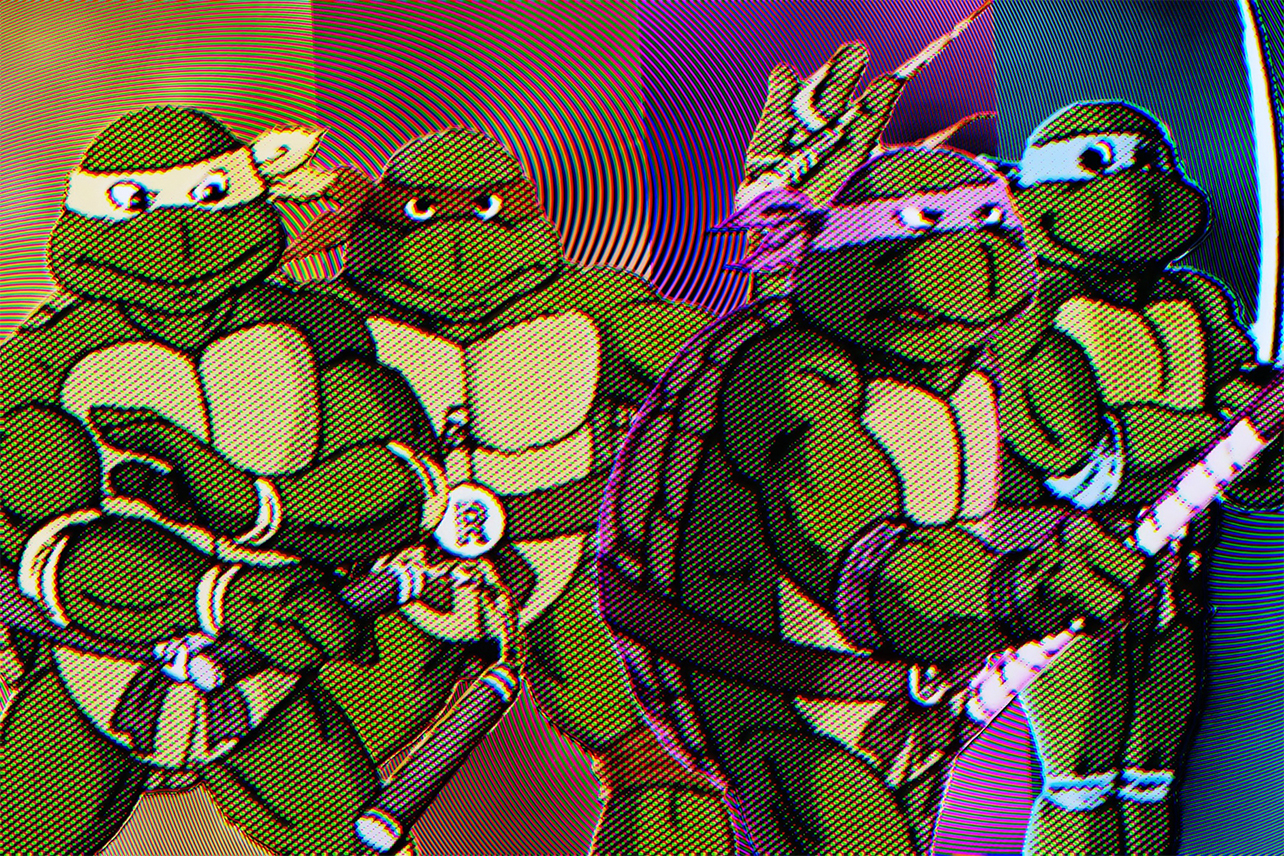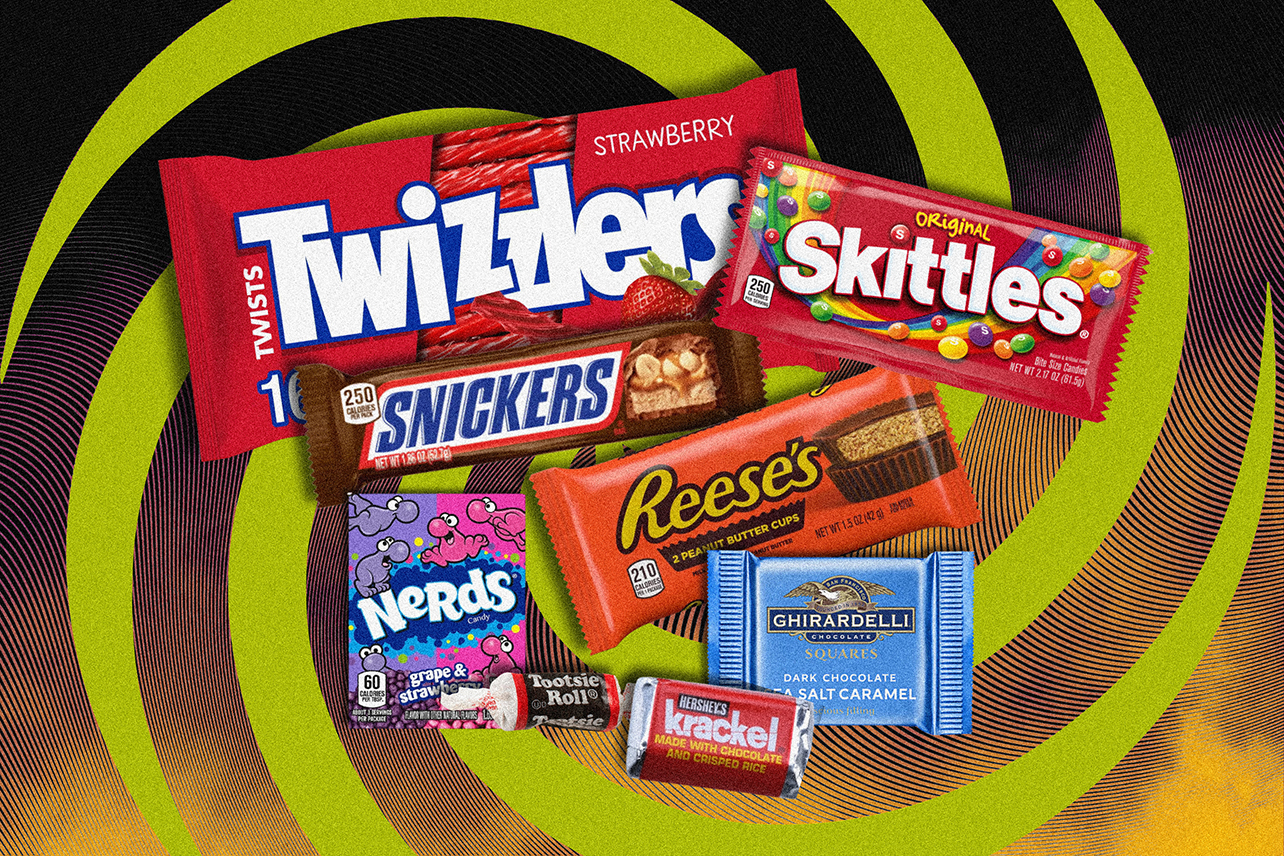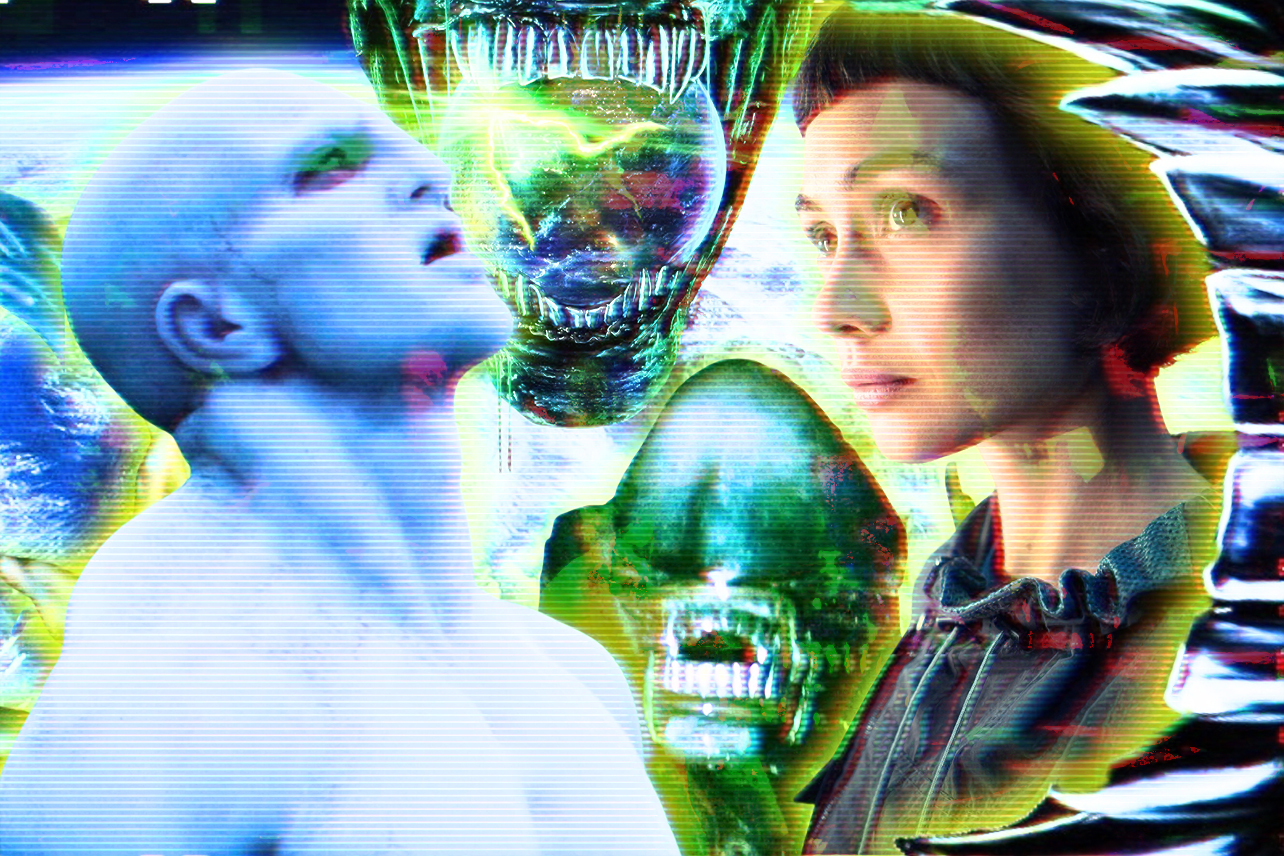I would start this Heist Guide with some snappy patter about how "you know it's summer because a Marvel movie is here" — but Thunderbolts* is the second Marvel movie to open in theaters in 2025 (after Captain America: Brave New World). And we're coming off a two-month run of Daredevil: Born Again Season 1, so, the more accurate snappy intro would be, "You know that it's any month of the year because there's a new Marvel something to watch." Anyway — Thunderbolts! With an asterisk!
You are no doubt asking yourself, "What is a Thunderbolt and why should I care?" Before you dismiss what appears to be Marvel's attempt at cashing in on the Suicide Squad movie nine years late (it's not — I'll get to that!), remember how you likely had no idea what a "Guardian of the Galaxy" was before summer 2014? Marvel is all about taking lesser-known comic properties and turning them into crowd-pleasing events. I mean, we've had three Ant-Man movies.
For Marvel Comics fans, though, a Thunderbolts movie has long been an inevitability if not an outright necessity. While the group doesn't have the back catalogue of the Marvel Universe's holy trinity of teams (Fantastic Four, Avengers, X-Men), the Thunderbolts have shown surprising staying power for a group introduced at the bleakest point in Marvel Comics history (also more on that in a sec).
Now it's the Thunderbolts' time in the spotlight ... even if, uh, Thunderbolts* (the movie) shares very, very little in common with Thunderbolts (the comic). Yes, this is going to be confusing. Bear with me, because you're about to learn everything you need to know about Marvel's super-antihero team.
Who are the Thunderbolts?
Let's start with the 2025 feature film team, since they're the ones who brought you here (SEO gods permitting). Thunderbolts* is a Marvel Cinematic Universe team-up movie that essentially rounds up a bunch of B and C-list characters from previous Marvel movies and puts them under the star power of one bona fide MCU A-lister: Bucky Barnes, a.k.a. Winter Soldier (Sebastian Stan).
The movie's premise is simple, and kinda familiar: Who does the United States government call upon when supervillain-sized problems emerge? Howsabout a team of ne'er-do-wells with sketchy AF pasts who generally have no qualms with with killing? Enter: the Thunderbolts*! Roll call!

Winter Soldier / Bucky Barnes (Sebastian Stan): He's Captain America's brooding bad boy best buddy, and another thawed-out super(ish) soldier from World War II — except Bucky's journey from the '40s to today was not a smooth one. Thought dead, he was captured by the Russians and turned into a mindless killing machine who was only defrosted to go on top secret missions. We saw his character growth from soldier hunk to killing machine to reluctant hero to full-blown mentor across the original Captain America movie trilogy and the Disney+ series The Falcon and The Winter Soldier. Now he's embracing his legacy as a do-gooder and looking for his own squad of Avengers.

Black Widow / Yelena Belova (Florence Pugh): Like her quasi-adoptive sister Natasha Romanoff, Yelena also grew up as a student/victim/prisoner of the Russian super spy program The Red Room. But while Natasha got herself extracted and attempted to atone as an agent of S.H.I.E.L.D. and Avenger, Yelena remained cut off from the world (and cut off from herself, frankly) until years later (as seen in Black Widow). Unfortunately for Yelena, her reunion with her big sis was a short one thanks to Nat's sacrifice in Avengers: Endgame. Now Yelena not only has to deal with finding a place in the world outside of the Red Room, she has to do so without any support system. Good thing this ragtag team found her!

Red Guardian / Alexei Shostakov (David Harbour): Oh — I said Yelena didn't have a support system? I lied. She doesn't have a support system that she wants to associate with. She does have Red Guardian, the Russian super spy who posed as her father when Yelena was a child. Since then, though, Red Guardian has become kind of a joke. His dreams of being Russia's Captain America are still fresh in his mind, even if he's not physically or mentally capable of making them come true. Or maybe he can, with a little help from his "daughter."
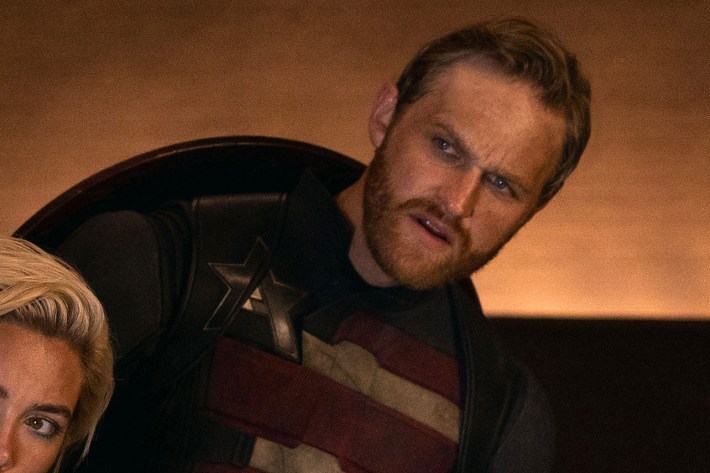
U.S. Agent / John Walker (Wyatt Russell): And then there's this guy, a former U.S. Army Ranger who was hand-selected by the government to be the new Captain America (Steve Rogers forgot to tell them that he'd already given the title to Sam Wilson). There were just a few problems: John Walker has traumatic PTSD from his tour(s) of duty and a whole lot of pent-up rage, not to mention the kind of "good ol' boy" personality that leads to less nuanced approaches to things. The guy thought he could take on the Dora Milaje. Come on, dude. Anyway — Walker very publicly decapitated a terrorist using his shield during The Falcon and the Winter Soldier, thus costing him his new title (Sam Wilson has it now, see: Captain America: Brave New World).

Ghost / Ava Starr (Hannah John-Kamen): You remember her, the primary antagonist from 2018's Ant-Man and the Wasp, right? Yeah, the Ant-Man movies, not so known for their villains. But Ghost was unique in that she wasn't a villain so much as an innocent victim of the Pym family's size-changing science. After a lab accident that also killed her father, she was left unable to maintain her molecular equilibrium, meaning she was effectively a ghost for much of her life — unable to touch anything. She became an assassin for S.H.I.E.L.D. and, yeah, had to go to some extreme lengths to heal herself that put her in conflict with Ant-Man and Wasp. But she's feeling much better now!
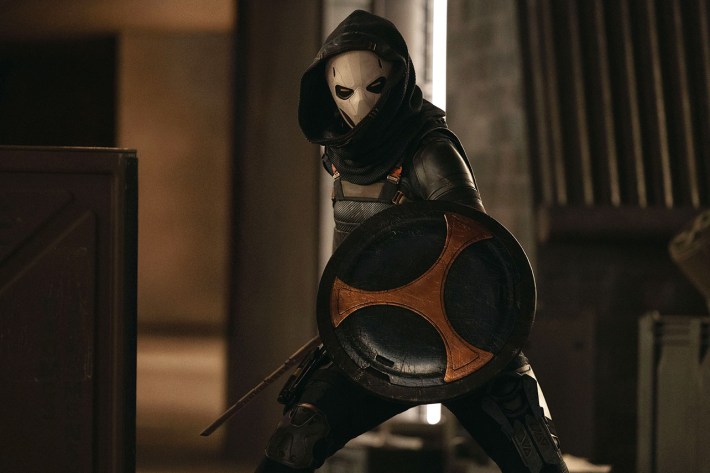
Antonia Dreykov / Taskmaster (Olga Kurylenko): And our third returnee from 2021's Black Widow. In that movie, Taskmaster was presented as a brainwashed killing machine with the ability to mimic the moves of any opponent. It was revealed that she was, in fact, the daughter of the Red Room's orchestrator, a young woman that Natasha Romanoff believed that she had killed. That film ended with Daddy Dreykov very much dead and Antonia free from his control for the first time in her adult life. Now she's a free agent ... or is she? Did she trade one master manipulator for another?
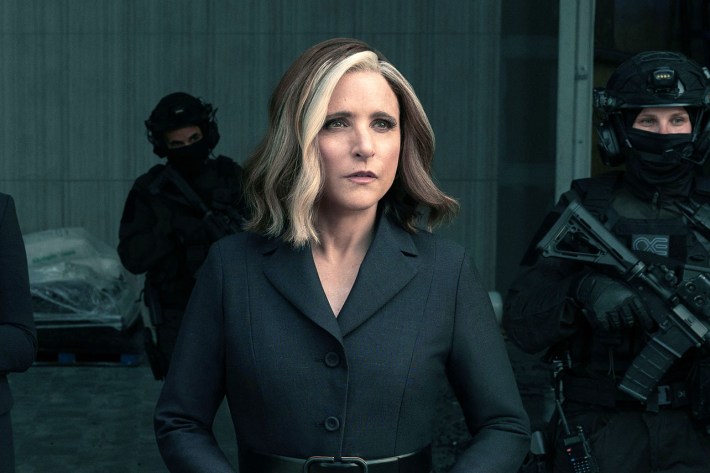
Contessa Valentina Allegra de Fontaine (Julia Louis-Dreyfus): The Avengers had Nick Fury, and the Thunderbolts* have The Contessa, the director of the CIA, the one and only Valentina Allegra de Fontaine. We've already seen her pop up on her recruitment drive: she recruited John Walker at the end of Falcon and Winter Soldier, and she recruited Yelena Belova in the Black Widow post-credits scene. Like the people she's recruited, she's not exactly good, or honorable, or trustworthy. Her motives remain a mystery, but it's likely she is after more than just that warm feeling of having saved the world.
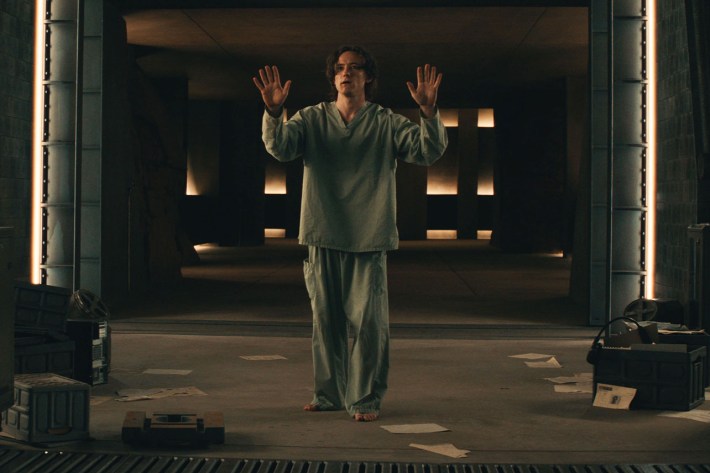
Bob (Lewis Pullman): Not much is known about the film's sole (advertised) newcomer. But knowing the comics, Bob is short for Robert Reynolds, a.k.a. Sentry. He is basically Marvel's answer to Superman — except he also has an all-powerful supervillain personality known as The Void. Sentry himself is also a rather staggering continuity black hole; his backstory is that he was one of the formative initial heroes of the Marvel universe, but in order to keep The Void at bay, a group of heroes banded together and erased the world's memory of him. It was a whole thing.
So, that's the movie! It is, for the most part, an entirely different thing from the comics.
Who are the Thunderbolts in the Marvel comics?
The cast and premise of Marvel's Thunderbolts is wildly different from what you see in the movie. Introduced in late 1996 in The Incredible Hulk #449, the Thunderbolts were a majorly-hyped, brand new superhero team consisting of wholly original characters — or so it seemed.
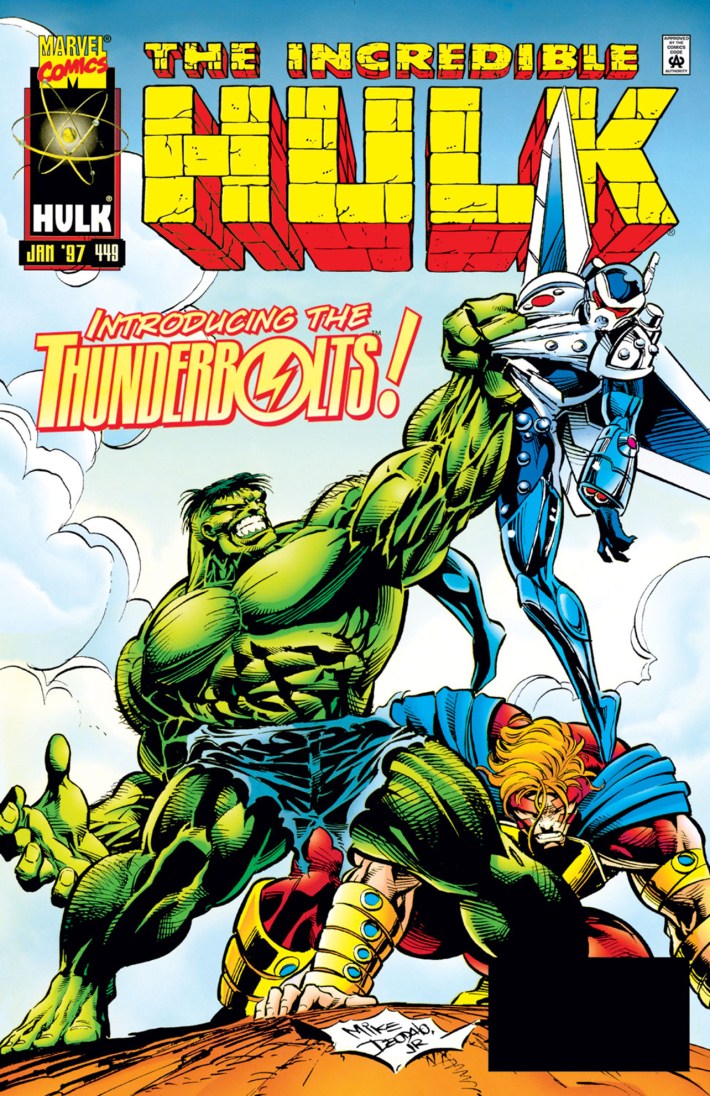
To set the stage: Marvel was in a bizarre state in late 1996 — both in-universe and IRL. In the comics, both the Avengers and Fantastic Four were believed to be dead following 1996's Onslaught mega-crossover. For the sake of expediency, I'm going to leave that at that. Pretty much every A-list non-mutant superhero? Gone. There was a void to fill.
IRL, Marvel Comics was in a financially precarious situation, to put it lightly. They were $600 million in debt and, on December 27, 1996, Marvel filed for Chapter 11 bankruptcy. For Marvel fans, this time felt incredibly bleak. I was 12 and just assumed that bankruptcy meant all my comics were getting canceled. That didn't happen, but wow, did that news ruin my 7th grade winter break.
How does this have anything to do with Bucky leading a team of killers for Elaine from Seinfeld?
Hold on! I'm just saying, the Thunderbolts debuted in the comics at a wild time. Marvel filed for bankruptcy literally a month after they debuted. There was, however, a lot of excitement around this team getting their own comic. They were this brightly colored beacon of hope — something truly new to get psyched about. There was a big guy, a guy who looked like a plane, a woman in gold armor, and a faceless dude with a big sword! Plus, it was going to be written by Kurt Busiek, author of the iconic Marvels miniseries, with art by Spider-Man superstar Mark Bagley.
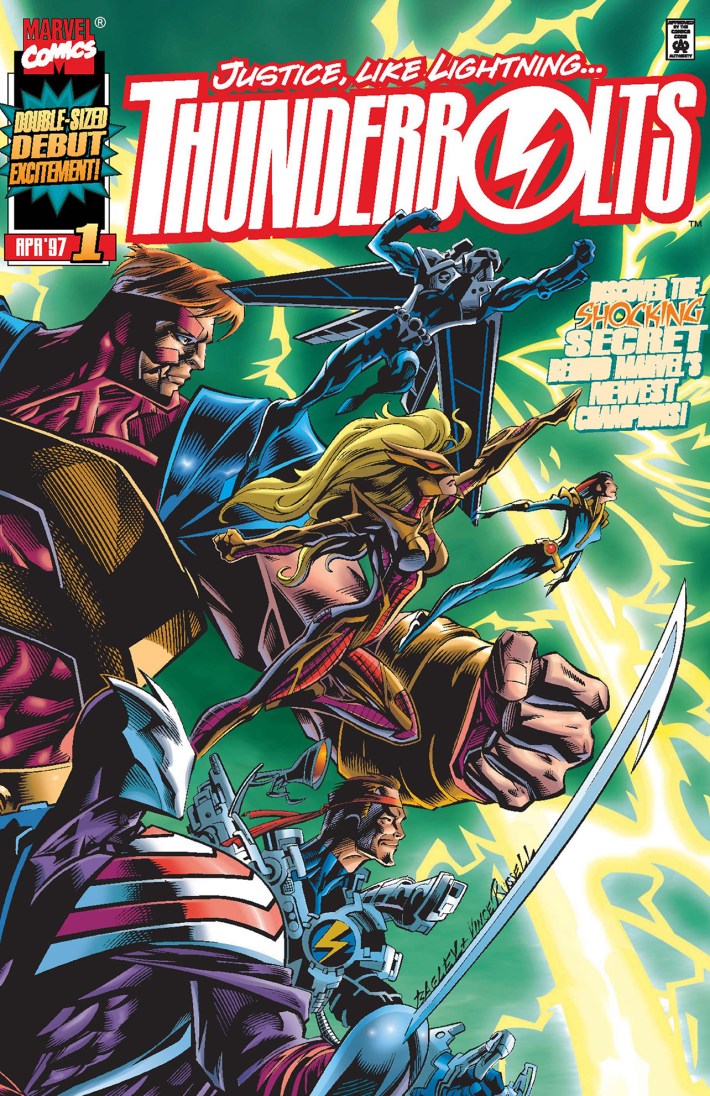
And then in February 1997, Thunderbolts #1 dropped. After months of anticipation, in a universe with so few heroes, and after the panic of filing for bankruptcy IRL, Marvel Comics felt like it was back, baby. That's why the last page remains one of the most shocking in comic history, and a masterstroke of marketing. The Thunderbolts were not, as had been sold to readers for months of buildup, a new team of superheroes.
They were, in fact, the Masters of Evil in disguise.

Who?
The Masters of Evil — they are exactly what it sounds like.
The Masters of Evil had been archenemies of The Avengers since 1964. Their lineup was expansive and ever-changing, but they were a constant threat. They even came very close to defeating the Avengers in a 1986 storyline wherein over a dozen of them just strolled up to Avengers Mansion and beat the daylights out of everyone who was home. These guys were not antiheroes that readers had rooted for at one point. They were all super villains, period. This surprise twist made Thunderbolts the most buzzed-about book of 1997 as readers watched diabolical characters trick the entire Marvel Universe. When would they be found out, and who would be hurt along the way?
Wow — Bucky, Yelena, John Walker, etc. were all irredeemable villains in the comics?
Funny you should mention them: None of those characters were part of the initial Thunderbolts team. In fact, the only character from the movie Thunderbolts* who has logged a significant tenure as a member of the comic book team Thunderbolts is ... Ghost. And MCU Ghost has nothing in common with Marvel Comics Ghost. Marvel Comics' Ghost is a hacker, master of corporate sabotage, and a paranoid creep who never takes off his uniform, and thus never bathes. It's canonical that Ghost smells terrible. Honestly, would love to see Hannah John-Kamen play this version.
So who the hell were the original Thunderbolts?
The original 1997 Thunderbolts lineup consisted of a pared down Masters of Evil roster. They were (from L to R):

- Techno / Fixer: A tech wiz who annoyed S.H.I.E.L.D. in the '60s. He got a major upgrade as Fixer, tech-wise, and got steadily more villainous as the series progressed.
- MACH-I / Beetle: A minor Spider-Man/Daredevil villain who wore a purple and green bug suit. As MACH-I, he essentially became a human-sized fighter jet. Fun fact: He changes his codename with every armor upgrade; as of 2016, he's MACH-X.
- Citizen V / Baron Zemo: HYDRA head honcho and son of the Nazi super villain who, 1945, engineered the accident that left Captain America in suspended animation and seemingly killed Bucky. So it's very much in bad taste for him to suddenly become a star-spangled swashbuckler.
- Songbird / Screaming Mimi: A member of the bad girl group The Grapplers who used her sonic scream to battle The Thing. She ditched the makeup to become Songbird, an enduring member of the team (she's on it right now) and a fan favorite.
- Atlas / Goliath: A size-changing supervillain and one of many characters to be called Goliath. Like MACH-I and Songbird, Atlas would only become more heroic.
- Meteorite / Moonstone: A psychiatrist and stone cold sociopath with an alien stone that gives her superhuman physical prowess and energy blasts. While Meteorite is probably the second-longest serving member of the franchise, she's still very much herself (re: evil).
And none of those characters are in the MCU?
Well, one of them is: Baron Helmut Zemo is a big part of the MCU. He was the antagonist of Captain America: Civil War and an unlikely ally and scene-stealer in The Falcon and the Winter Soldier. He was played by Daniel Brühl.
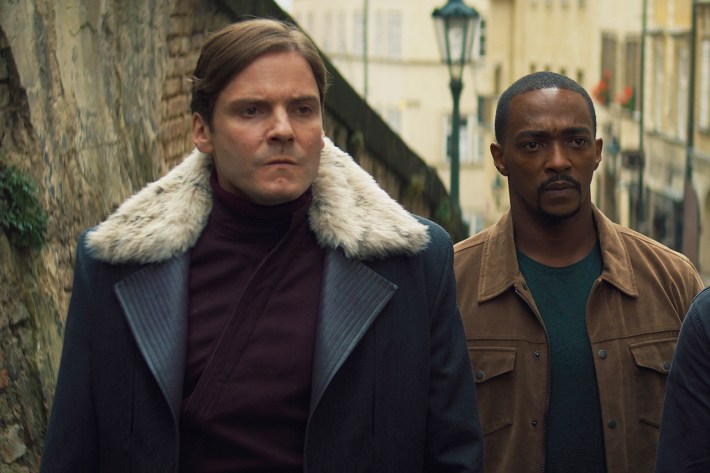
Wait — so we could have had Daniel Brühl in Thunderbolts*?!
Yeah, and I'd even change that "could" to "should." Zemo was the founder of the Thunderbolts. The whole thing was his idea. And even though plenty of others have led the team or started their own independent iterations of the Thunderbolts, Zemo remains synonymous with the moniker. So the fact that the MCU Zemo is supposedly just sitting in super prison, twiddling his thumbs while Bucky runs around stealing his thunder? It's kinda wild.
If the original Thunderbolts were villains posing as heroes, when did the team become a Suicide Squad ripoff?
Okay, "ripoff" is both accurate and a disservice to the Thunderbolts comic. The initial villains-posing-as-heroes conceit actually didn't last that long. By Thunderbolts #12 (1998), barely a year into the run, the jig was up — but the story didn't stop. The series continued as the members slowly became either genuine good guys (MACH-I, Atlas, Songbird — all still heroes to this day) or somehow went from bad guys to even-worse guys (Meteorite, Fixer, Citizen V). The team was even led by Hawkeye for a while, himself a small-time Iron Man villain before joining the Avengers.
As for the Suicide Squad of it all — okay, I'm going to have to talk about eras.
Please don't bring Taylor Swift into this.
I don't know her. The Thunderbolts have had so many eras — probably too many, to be honest. It's kinda diluting the brand. But those eras break down into:
- 1997-1998: The Masters of Evil posing as heroes era.
- 1998-2003: The Hawkeye era, where the Thunderbolts are more or less a standard — and cult favorite — superhero team.
- 2003: The very short-lived, ill-advised Ultimate Brawling League era (irrelevant to our topic)
- 2004-2006: New Thunderbolts era, with a mix of OG 'Bolts and some new villains on the redemption path.
- 2007-2010: The Dark Reign era, where Norman Osborne (the Spider-Man villain) takes over and stacks the team with cold-blooded killers. And Songbird. Poor Songbird. In the early part of this run, Yelena Belova is part of the team — but is ultimately revealed to be Natasha in disguise. So, doesn't count. But this is when Ghost joins the team, and he (yes, he — aside from the powers, he's a completely different character) sticks around for four years.
- 2010-2013: The "Suicide Squad" era — which ...
... is my favorite Thunderbolts era. Writer Jeff Parker and artists Kev Walker and Declan Shalvey turned this into a dark, hilarious team book that stayed great for years. Yes, this era started with the T'Bolts made up of prisoners from The Raft who were sent on missions, led by Luke Cage.
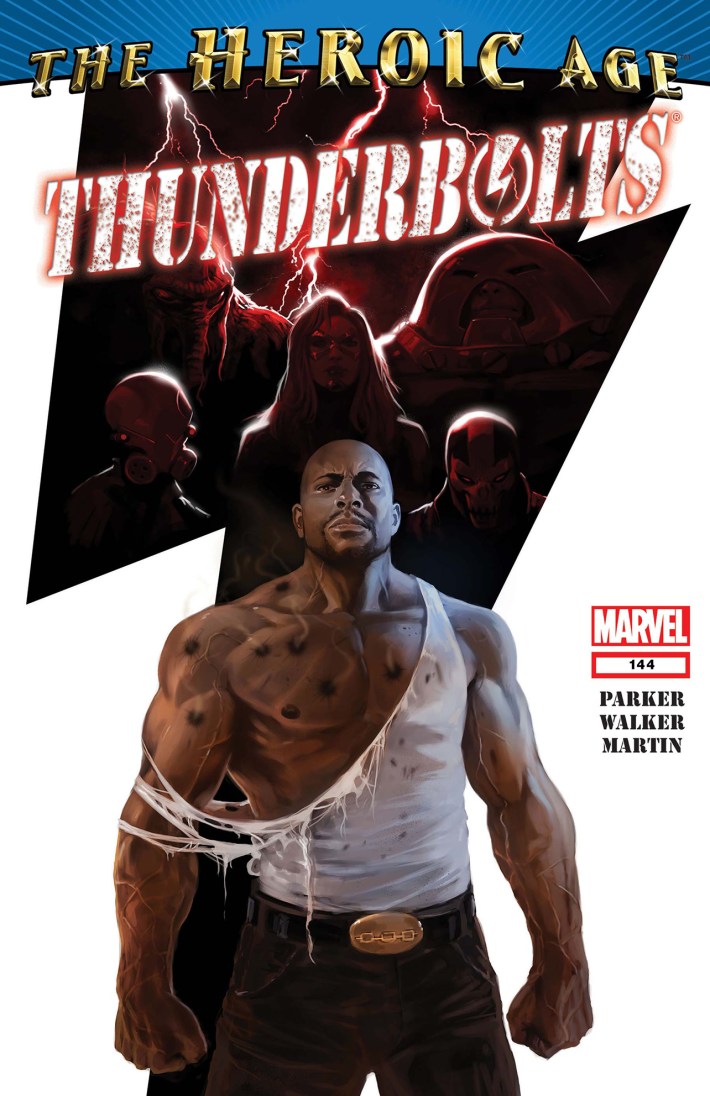
It's very Suicide Squad-y. But it's great. This run features John Walker as the warden of the Raft, and he later joins the team as U.S. Agent— or, rather, he joins an evolution of the team? I'm trying to keep this succinct but comics make it hard.
- 2012-2014: Overlapping with that era was one where the theme was red, the Red Hulk era. And everyone wore red. I don't know. Yes, Deadpool was on the team.
- 2016-2017: First Winter Soldier Era, where Bucky teams up with a chunk of the original roster. So Winter Soldier being the lead of the movie isn't that much of a stretch. Still, he's only been a member for some 20 issues spread out across nine years.
- 2021-2022: Then we got a quasi-return to the Dark Reign vibe, instead with Mayor Wilson Fisk putting a team together. Taskmaster leads the team (and, like Ghost, the MCU Taskmaster is a completely different character).
- 2022: Then immediately after that, there's a second Hawkeye era where the whole conceit of bad guys going good is chucked out the window.
- 2024-2025: Now another Winter Soldier era (Hawkeye who?) that ties into [drumroll] Thunderbolts*! Bucky, Valentina, Yelena, Red Guardian, and U.S. Agent are all present.
- Summer 2025-?: And Marvel has already announced that the team is getting another reboot, this time with Bucky and Black Widow (Natasha, not Yelena) leading a team consisting of Wolverine (Laura Kinney), Carnage (Eddie Brock), Namor, Hulk, and Clea.
Got all that? It's a lot. In my opinion, Marvel has kinda not known what to do with the Thunderbolts as a concept or brand since 2014. That was the last time that any of these iterations had any staying power. We've had four different takes on the team in the past four years. That's wild.
Did I need to know all of that to go see this movie?
Absolutely not, but I do think that if the movie makes you interested in the Thunderbolts comics, you're in for a big surprise.
So if I liked Thunderbolts* and want to read some good Thunderbolts comics, what should I read?
If you liked the characters of Thunderbolts*, go for the current iteration of the comics. That starts with Thunderbolts: Worldstrike and apparently concludes with Thunderbolts: Doomstrike.
If you liked the tone and general premise, but are up for meeting a different batch of weirdos, please start with Thunderbolts: Cage (or get the entire run in one fell swoop in Thunderbolts: Uncaged).
If the whole "supervillains posing as superheroes for a long con" premise of the original comic sounds intriguing, then go back to the beginning with Thunderbolts Epic Collection Vol. 1: Justice Like Lightning.
Hope you got all that. Comics — ask a simple question, get 3,000 words of continuity mess for an answer!
If you haven't already, consider supporting worker-owned media by subscribing to Pop Heist. We are ad-free and operating outside the algorithm, so all dollars go directly to paying the staff members and writers who make articles like this one possible.
